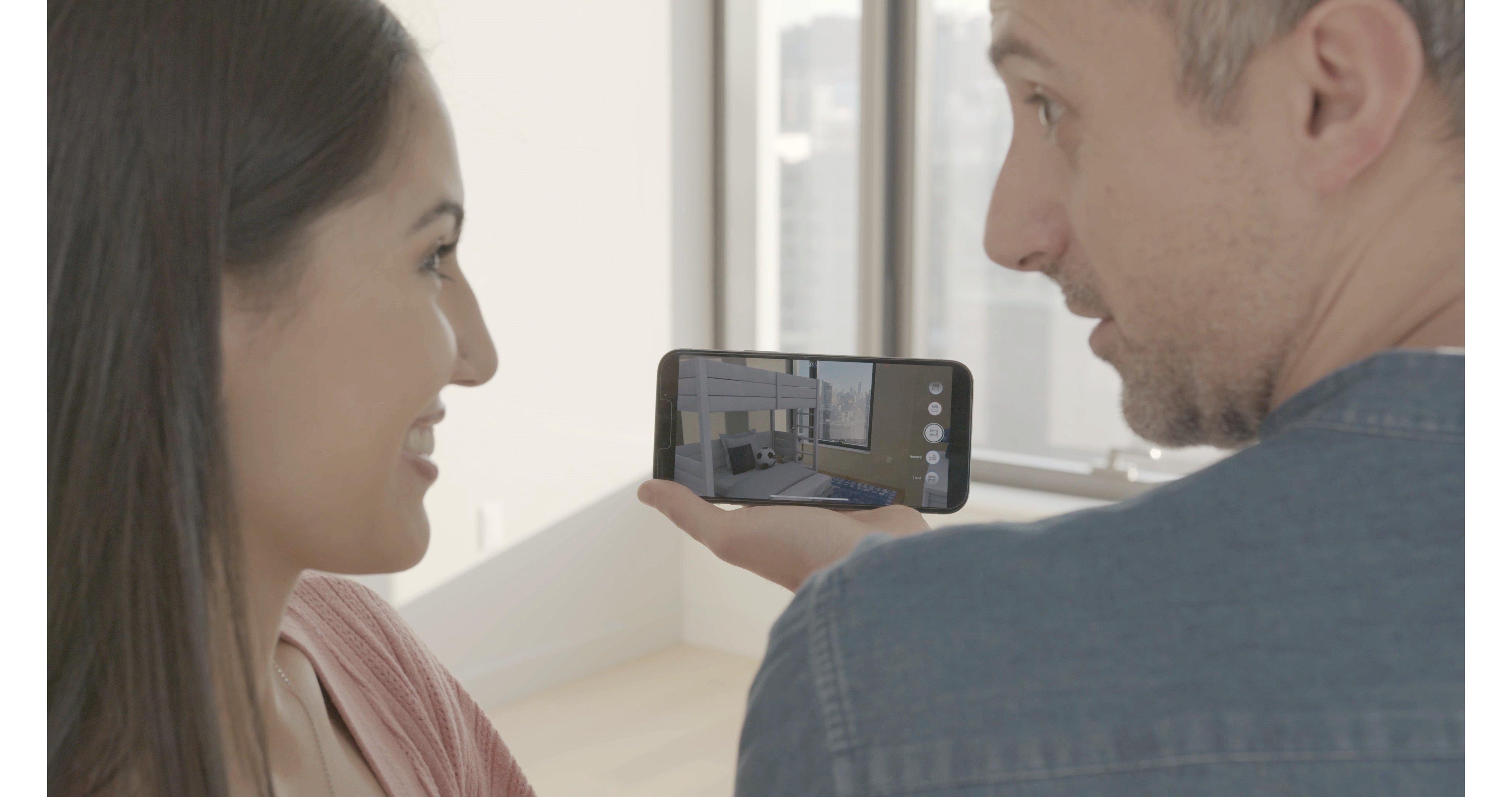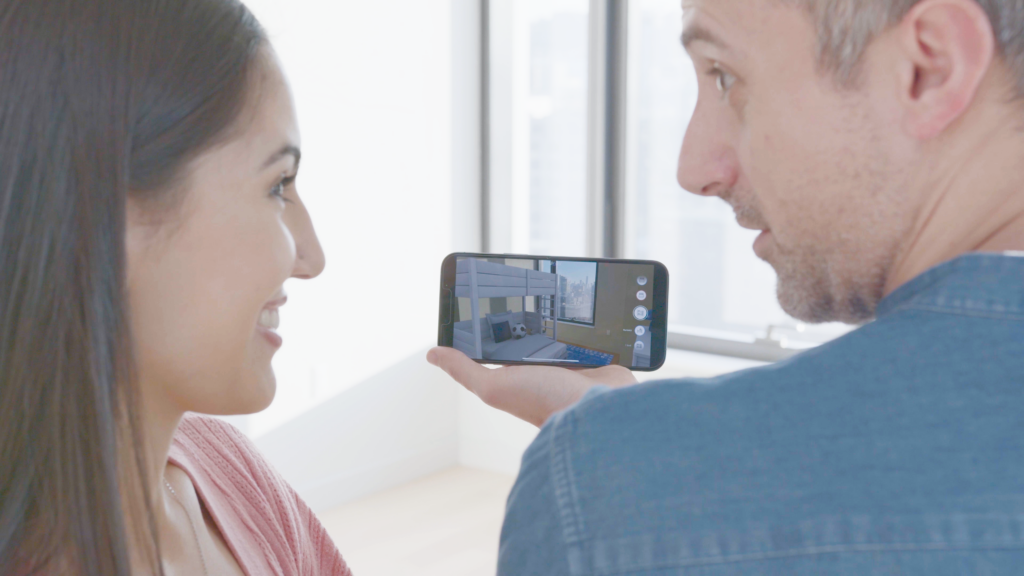
Augmented Reality (AR) offers a dynamic experience that virtual staging cannot match, learn why real estate professionals need to embrace this technology.

Augmented Reality transforms both in-person and online property views, unlike virtual staging, which only alters online images. AR makes it simpler for buyers to imagine the space as their own and visualize themselves living there.
Today’s landscape for optimal property presentation has drastically evolved since Barb Schwartz pioneered home staging in 1972. Her innovative approach of employing interior designers and physical furniture has given way to an era where virtual staging emerges as an affordable option. However, the effectiveness of virtual versus AR staging hinges on various factors. In this rapidly changing environment, real estate agents must stay abreast of emerging trends, including technological advancements like augmented reality, to ensure their property listings capture and retain buyer interest effectively.
Virtual Staging vs Augmented Reality Staging
The primary distinction between virtual staging and augmented reality (AR) staging lies in the in-person viewing experience of the property. Virtual staging is confined to enhancing online photographs, where the property is digitally furnished for visual appeal online.
In contrast, AR staging allows for a more dynamic interaction; it uses digital technology to overlay virtual furniture in real-time, offering a consistent visual experience both in the online images and during physical viewings of the property.
Augmented Reality (AR) staging merges traditional physical staging with virtual staging, addressing some of the limitations of both approaches while leveraging their strengths.
Here’s how AR staging meets in the middle:
- Enhanced In-Person Experience: Potential renters can use AR technology to see a furnished version of the property during their visit, offering a tactile and spatial understanding closer to that provided by traditional staging.
- Cost-Effectiveness, Flexibility, and Scale: Similar to virtual staging, AR staging can be more cost-effective than traditional physical staging. It offers the flexibility to customize digital furnishings according to target demographics, without the high costs associated with physical furniture handling and setup. In addition, it can be done at scale throughout entire apartment communities with ease.
- Quality and Realism: The quality of AR staging, like virtual staging, depends on the digital work. However, AR technology has advanced to provide highly realistic and accurate representations, reducing the risk of misrepresentation and the need for imagination during in-person viewings.
- Time Efficiency: AR staging shares the time-saving benefit of virtual staging. It eliminates the need for physical furniture logistics, allowing for quick and efficient property preparation.
- Transparency in Marketing: With AR staging, there’s less risk of misrepresentation in listing photos, as the technology can be used to clearly indicate which elements are digitally added and bring the digital elements to in-person tours. This transparency and technology can build trust + excitement with potential renters.
- Unified Solutions: With AR staging, you have the advantage of seamlessly creating limitless virtually staged photos and videos for your property listings without incurring any additional costs.
What is Virtual Staging?
Virtual staging exists exclusively online by taking photos of an empty room and editing them with software such as Photoshop to dress up the image with furniture. The furniture helps elevate the aesthetic of the photo and hopefully draws extra attention away from the competition. Ideally, the result of virtually staging the photos of an apartment will convince prospective tenants to book a tour with the leasing team.
Why are marketing teams virtually staging apartments?
When an apartment is available to rent, the leasing team needs it to look its best so that the ideal tenant is attracted to the apartment as early in their search as possible. A staged apartment boosts the appeal and simply makes a better impression on prospective tenants. In the changing world of online advertising, drawing interest from prospective tenants is a completely different challenge. A report by Properties Online found that 95% of home buyers are using the internet to search for a home. Marketing a property with photos of empty rooms becomes a problem when it is pinned up against professional photos of beautifully staged apartments elsewhere. Photos of empty rooms don’t allow prospective tenants to easily envision themselves living in the space or understand the architecture and scale of each room online.
Pros and Cons of Virtual Staging
While existing exclusively online, virtual staging has both some advantages and disadvantages.
Pros
- Striking Visual Appeal: Virtual staging produces high-quality, realistic visuals that enhance the overall appeal of a property, capturing the attention of potential buyers. You can also make a small space look bigger, using the right camera angle and use of virtual furniture
- Improve listing visual at low cost: With many different vendors that supply virtual staging popping up, virtual staging is becoming a commodity, According to the NAR article discussing virtual staging, companies such as Barion charge $49 – $399 per photo and BoxBrownie charges $24 – $400 per image.
- Design Versatility: The flexibility of virtual staging allows for easy customization of furniture styles, layouts, and designs, catering to diverse preferences. For example, a family-oriented home can be staged differently than a property aimed at young professionals.
- Adaptability to Design Trends: Virtual staging exhibits a swift capacity to align with prevailing design trends, ensuring that the property remains visually relevant and appealing to the current market. Additionally, it allows for prompt updates as needed.
Cons
- Lack of Physical Experience: Unlike traditional staging, virtual staging doesn’t allow potential renters to physically experience the space. The tactile and spatial understanding that comes from walking through a fully furnished home is lost, which can be a significant factor for some renters.
- Dependence on Quality of Work: The effectiveness of virtual staging heavily depends on the quality of the digital work. Poorly executed virtual staging can look unrealistic and unappealing, potentially deterring renters.
- Potential Misrepresentation: There’s a risk that virtual staging might make a space appear larger or differently shaped than it actually is. This could lead to disappointment or a sense of mistrust when potential renters visit the property in person and see the real dimensions and conditions.
- Requires Imagination for In-Person Viewing: While virtual staging helps online viewers visualize the space, those visiting the property will see an empty space. They must rely on their memory or imagination, which can be challenging for some renters.
- Not Always Recognized in Photos: It may not always be obvious in listing photos that a property is virtually staged, which can lead to confusion or misunderstanding about the state of the property when renters visit.
Conclusion
Although virtual staging is less expensive, it doesn’t completely replace traditional staging because it can’t provide a real-life experience. Augmented Reality (AR) staging has the potential to bridge this gap. AR in real estate enhances in-person property tours by integrating the benefits of digital visualization without the logistical challenges of physical staging. Moreover, AR staging doesn’t depend on having actual furniture, offering a scalable solution in the case of an apartment complex, turning all units in a community into a staged unit.
Why Choose SparX? Our unique approach combines virtual staging with augmented reality, offering a scalable staging service. When we say scalable, we mean that every apartment and floor plan can be effortlessly staged both on-site and online, providing high-quality virtual staging images with ease and at a low cost.
You’ll win the attention of online prospective tenants with virtually staged images and videos. With the SparX app on tours, augmented reality brings the empty apartments alive.
If you’d like to read more about how augmented reality staging compares to model units, here is our article, Model Units vs. Augmented Reality Staging
